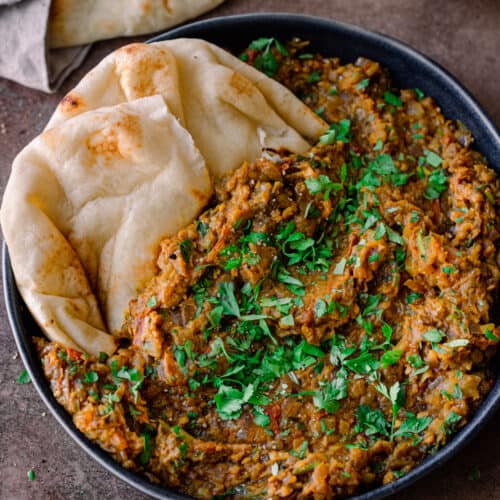Whenever I ask y’all which Indian recipes you’d like to see, Baingan Bharta is always high on the list. So I’m excited to finally share my version. It’s silky and jammy in texture, boasts a tantalizing smoky aroma, and is brimming with warm, pungent Indian spices.
It requires relatively few ingredient and is naturally vegan, gluten-free, nut-free, and soy-free, so it’s allergen-friendly. Serve it as a main course with some homemade vegan naan and gobi manchurian or serve it as as a side dish with some dal tadka or vegan palak paneer!
PS: If you or your family members are eggplant skeptics, rest assured this is the one eggplant dish that even eggplant haters will enjoy. My partner Max has a blanket “I hate eggplant” policy, but I was able to sneak this one on him because it doesn’t look like eggplant. And he not only enjoyed it, but asked for seconds.
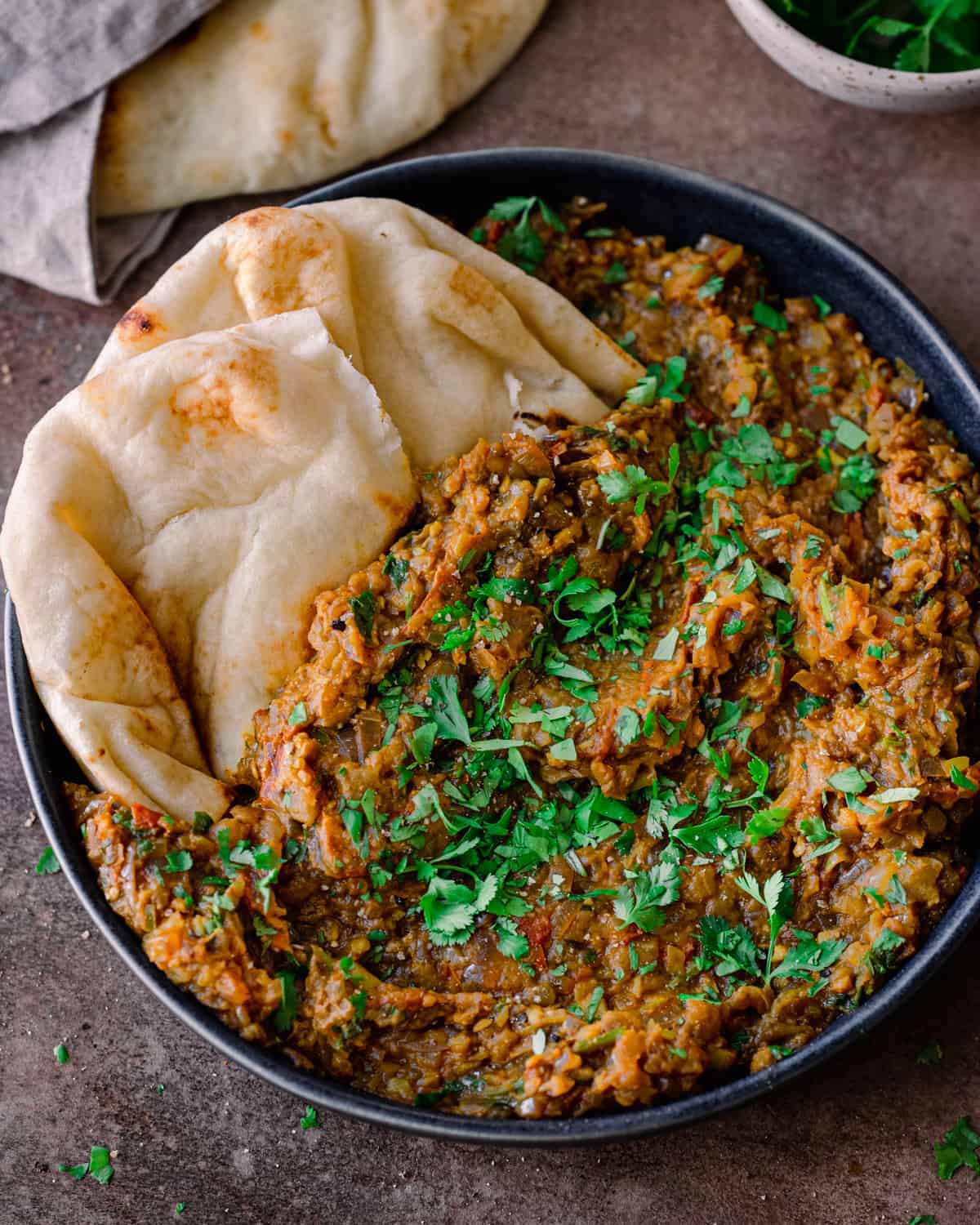
What is Baingan Bharta?
Baingan Bharta is an eggplant dish originating in the Punjab region of India, though there are many regional variations (as with almost every dish in a country as diverse as India). It’s smoky, spicy, and tangy, and so flavorful!
In Hindi, baingan means eggplant and bharta means mash or filling (sometimes, the dish is also called baingan ka bharta, or mash of eggplant).
First, for the baingan: You roast a whole eggplant over an open flame until the skin blackens and chars, which infuses the entire eggplant with a smoky aroma and taste. In Punjab, the eggplant is often roasted in the tandoor oven, which infuses it with that smoky charcoal aroma. Obviously that’s not possible in a home kitchen, but a flame on a gas stove works really well. Once you smoke the eggplant, you peel it and mash up the flesh,
For the bharta: You’ll sauté aromatics like onions, ginger, garlic, and green chiles in a bit of oil, along with a few spices like coriander and red chile powder; then you’ll add some tomatoes for that tangy flavor and cook until soft. Finally, add the eggplant mash into the bharta and cook everything together to blend the flavors.
Fun fact: eggplant, AKA aubergine, originated in India and is believed to have been around for thousands of years!
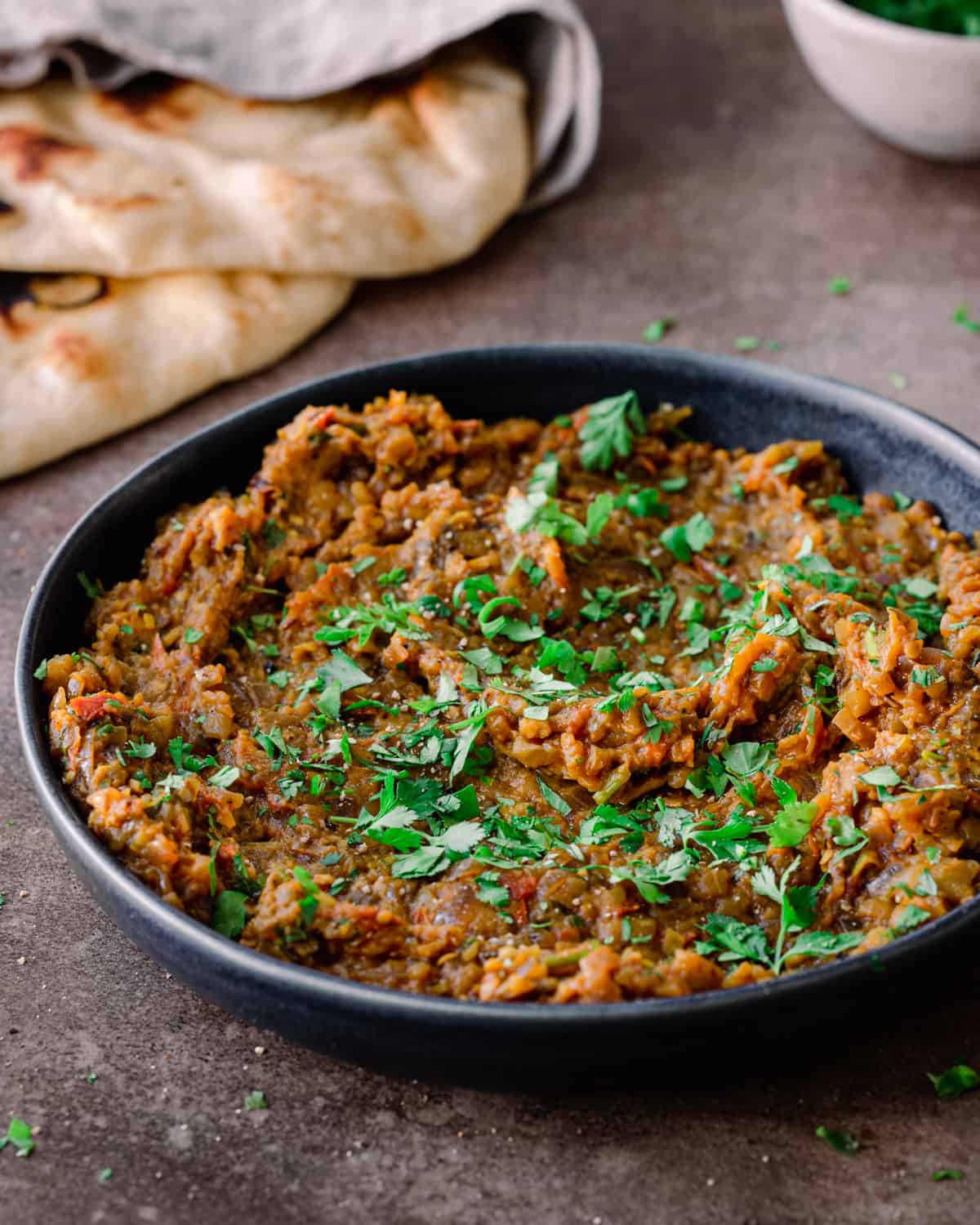
How to make the best Baingan Bharta
At its core, this is is a pretty simple dish featuring minimal ingredients. The one “secret” to the most flavorful baingan bharta is to smoke the whole eggplant over an open flame until charred and almost falling apart. This infuses every bite of eggplant with the smoky aroma and taste that is a hallmark of this dish.
I actually tested this recipe using five different methods for cooking the eggplant: (1) char a whole eggplant over an open flame; (2) roast a whole eggplant in the oven; (3) grill whole eggplant on a grill pan; (4) roast chopped eggplant in the oven; and (5) sauté chopped eggplant in a frying pan.
Methods 2, 3, and 4 were no-gos. (2) Roasting the eggplant whole in the oven gave me watery eggplant with zero flavor. (3) Grilling the eggplant whole in a grill pan added a little more flavor but not any smokiness. (4) Roasting chopped eggplant (tossed with oil and salt) was definitely more flavorful but the eggplant dried out a bit too much and didn’t mash well (and of course there was no smoky element).
The best method, no surprise, is the “authentic” method: smoking a whole eggplant over an open flame (on your gas stove). It adds that bold smoky aroma and makes the eggplant flesh silky and unctuous.
However, for those who don’t have a gas stove or don’t feel comfortable with this technique, method 5—sautéing chopped eggplant in oil and salt in a frying pan—also worked quite well, producing soft, jammy eggplant that was easy to mash and had nice eggplant flavor. Of course, it doesn’t give you that classic smoky flavor, but as you’ll see below, you can infuse smoky flavor into it with another quick method.
Step-by-Step Instructions
Gather your ingredients.
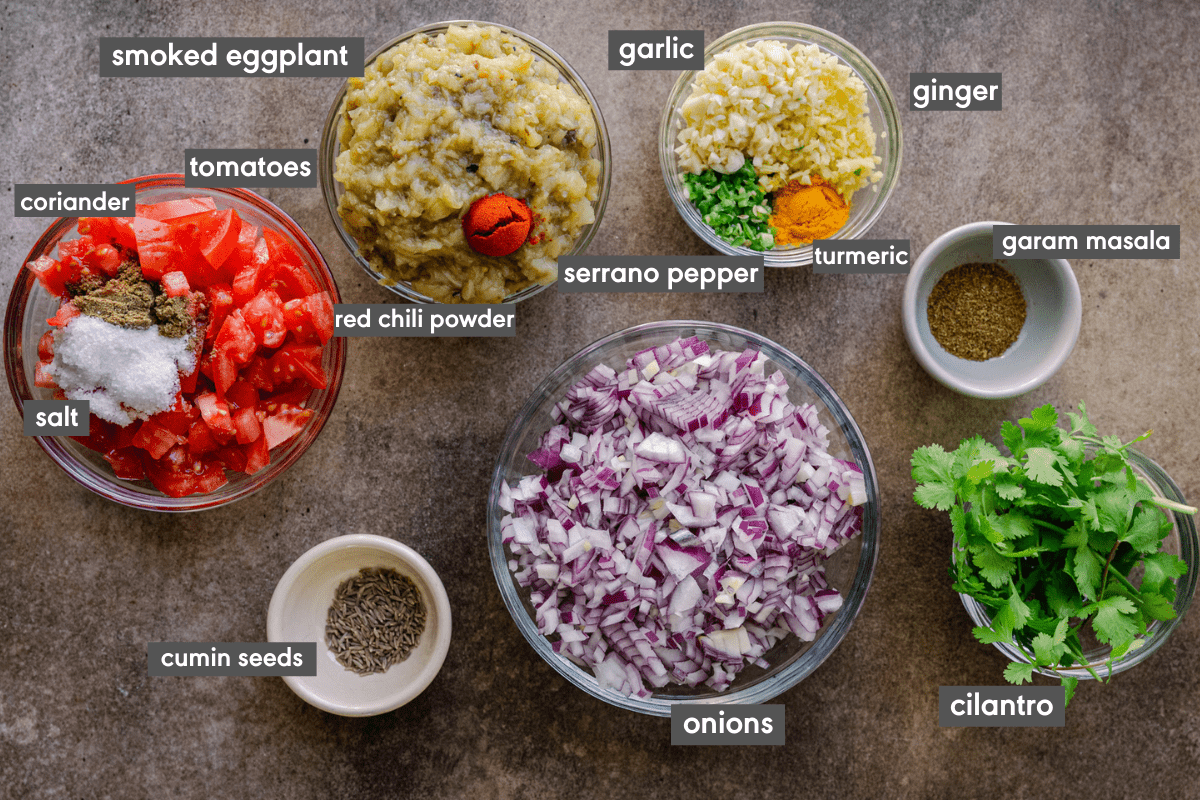
Cook the eggplant.
The below photos/instructions are for roasting the eggplant directly over a stove flame (the traditional method of making baingan bharta). If you’re not comfortable with this method or don’t have a gas stove, use the sauté method, which is outlined in the recipe card notes below.
Brush the eggplant with a light coating of oil and peel off/trim as much of the stem on top as you can (to avoid burning). Heat a gas burner over medium-low heat.
Use tongs to hold the eggplant upright over the flame; char the bottom of the eggplant for 4-6 minutes.
Flip the eggplant upside down and char the top for about 3 minutes. If the stem starts to burn, take it off the heat and try to trim more of it off.
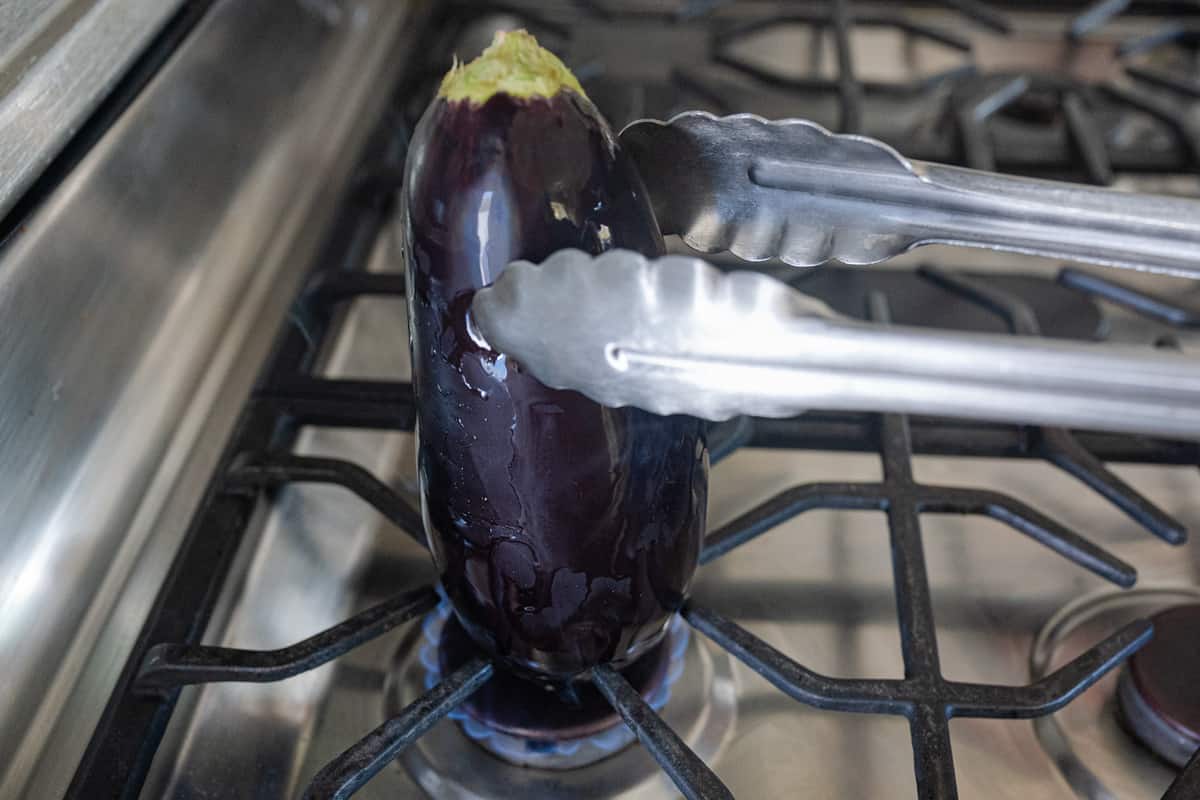
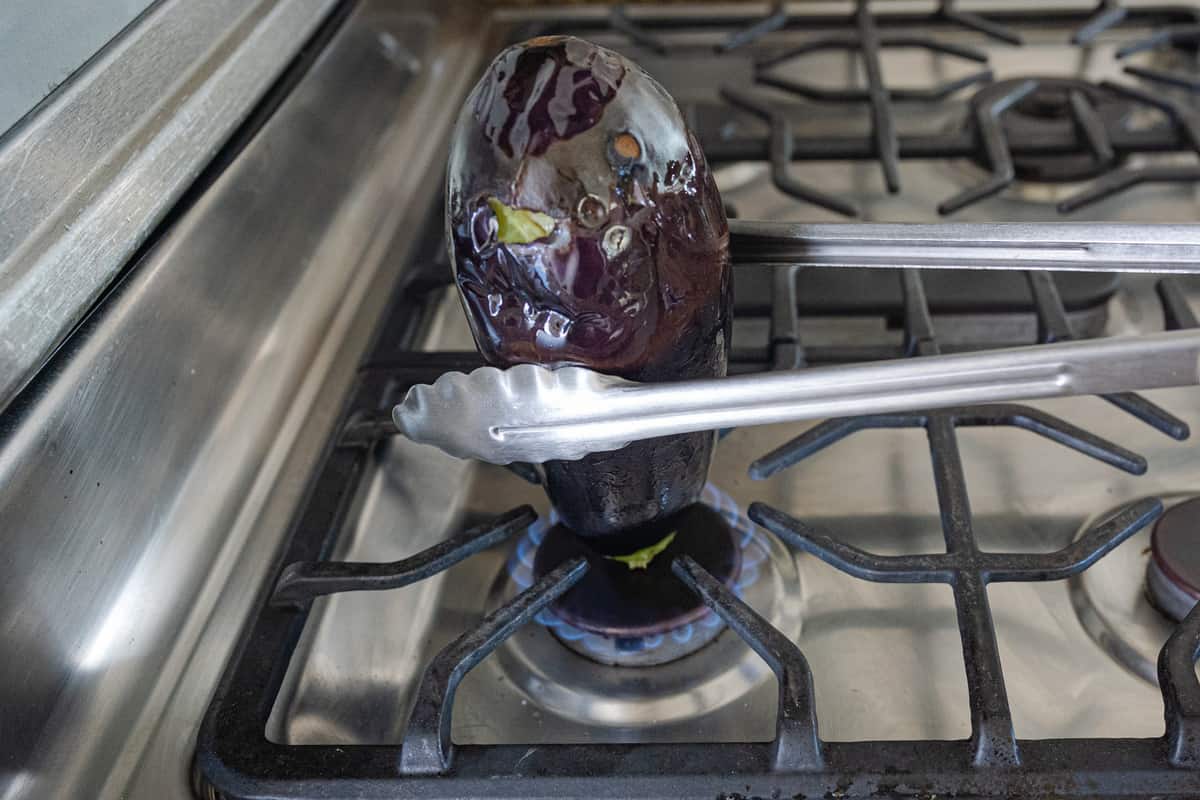
Flip the eggplant on its side and position the thicker bottom half directly over the flame. Cook, rotating every 2 minutes, for 15 to 20 minutes, or until a knife can easily pierce the fattest part with no resistance.
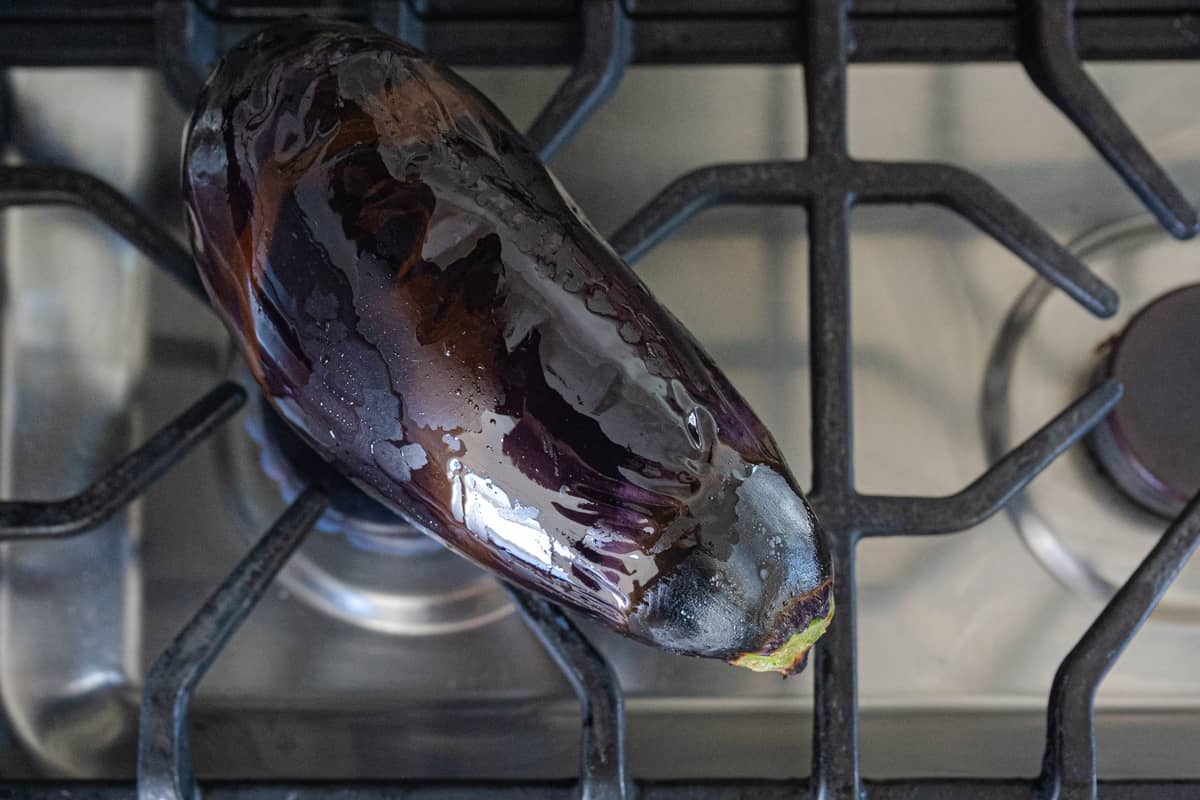
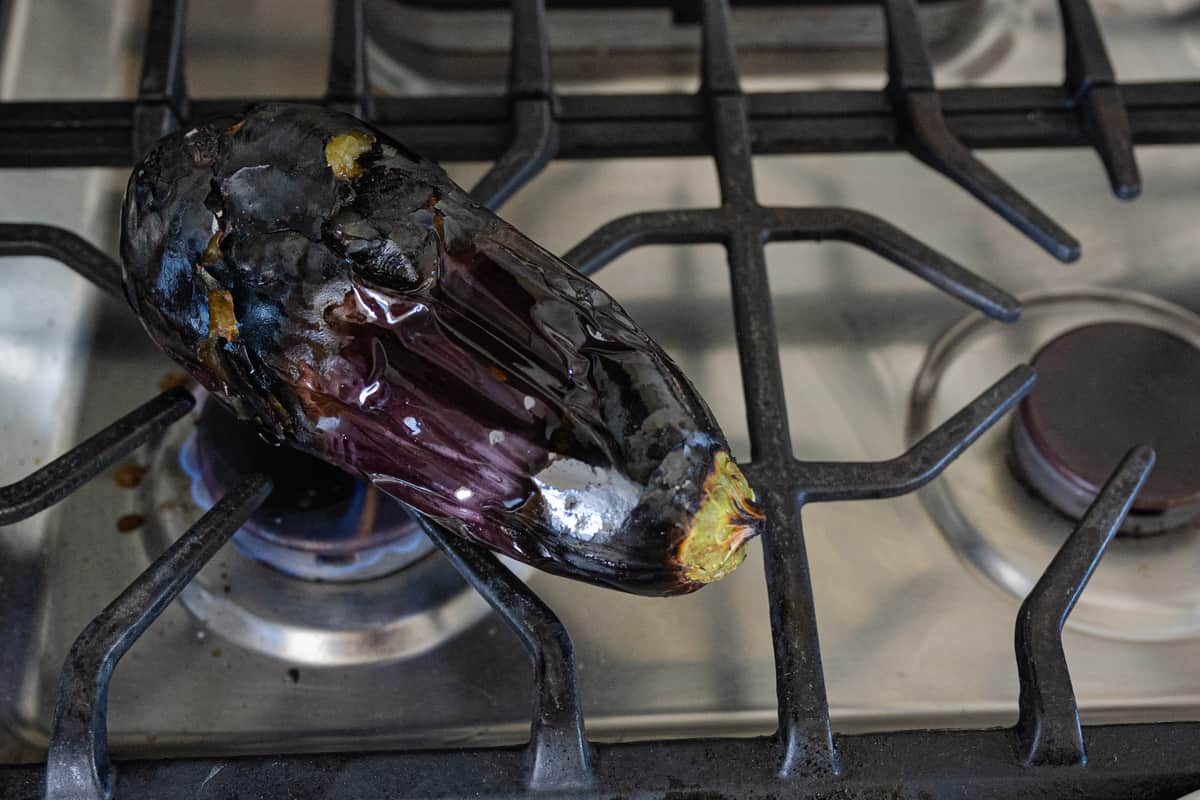
Move the thinner top half of the eggplant directly over the flame. Cook, rotating every 2 minutes, for a total of 6 minutes.
The eggplant should be deeply charred all over, wrinkly, and almost falling apart, like the photo on the right.
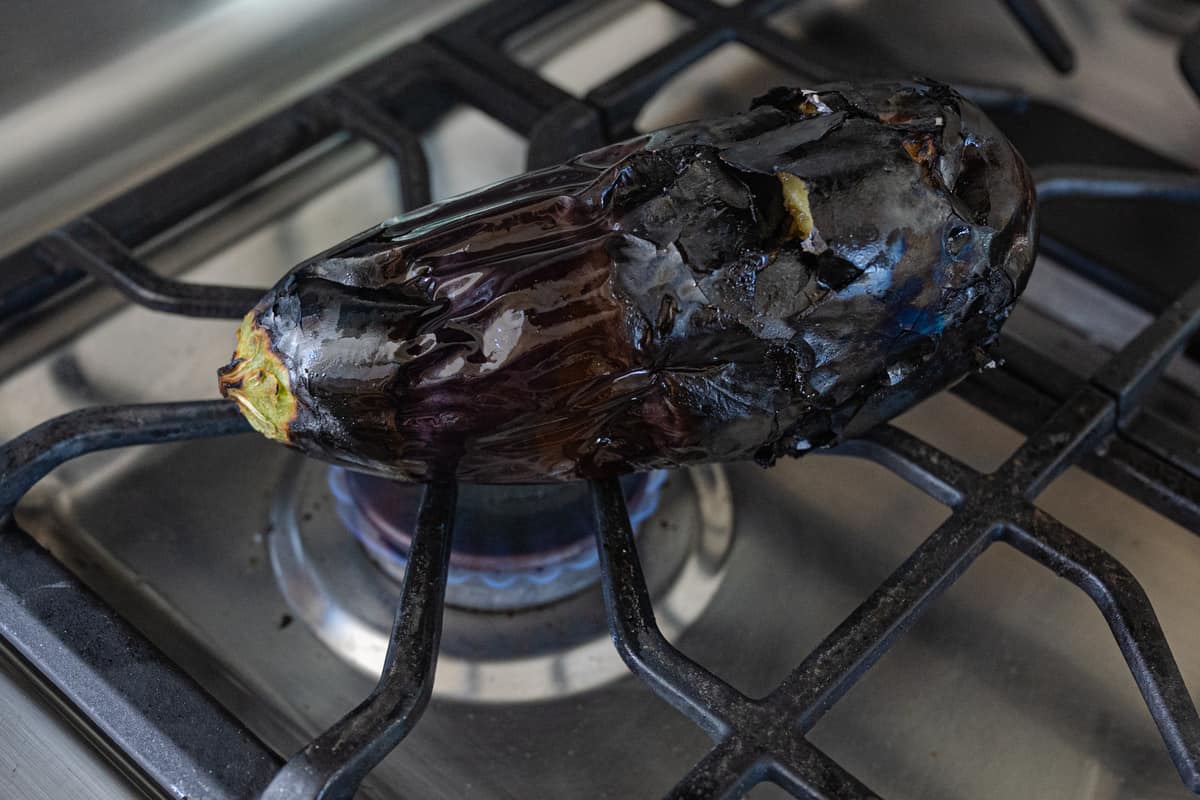
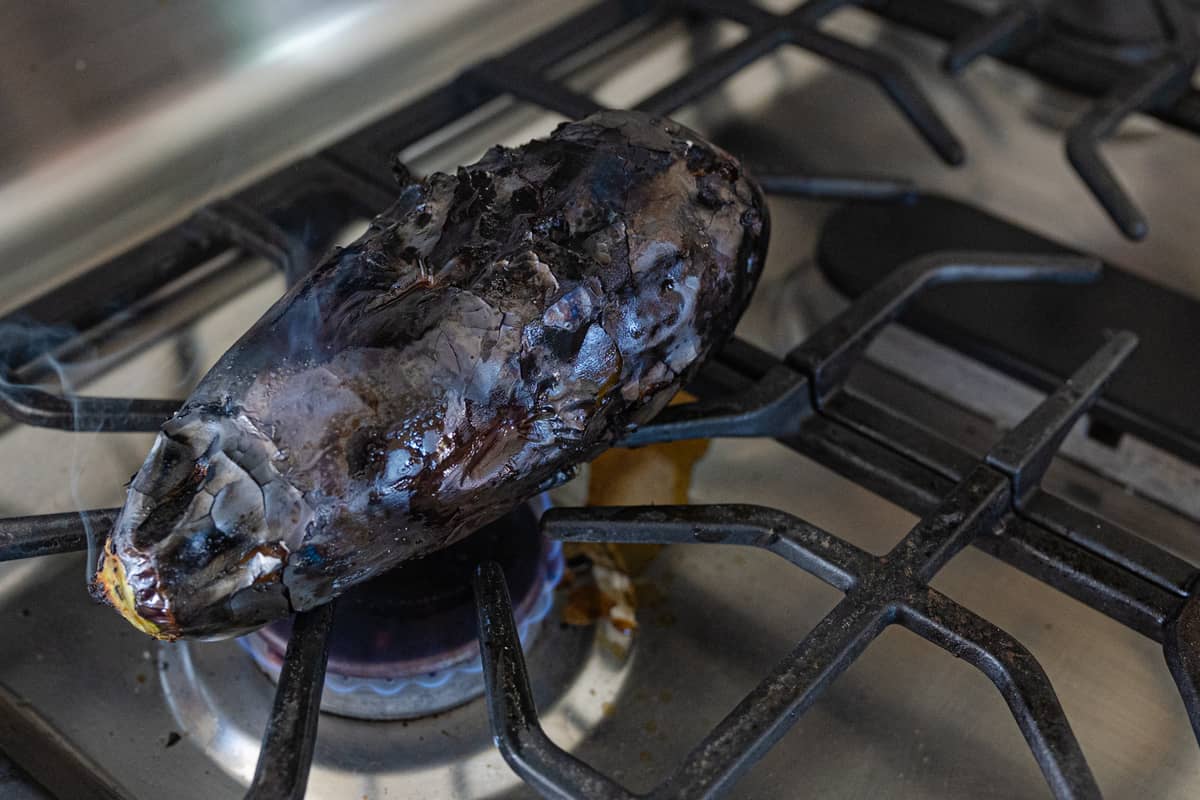
Use tongs to transfer the eggplant to a bowl, and cover with a plate to steam for 5 minutes (this is essential for making the eggplant easier to peel).
Use your hands to peel off the skin (you may want to dip your hands in a bit of water to make it easier to peel). Remove any ashy black bits from the flesh.
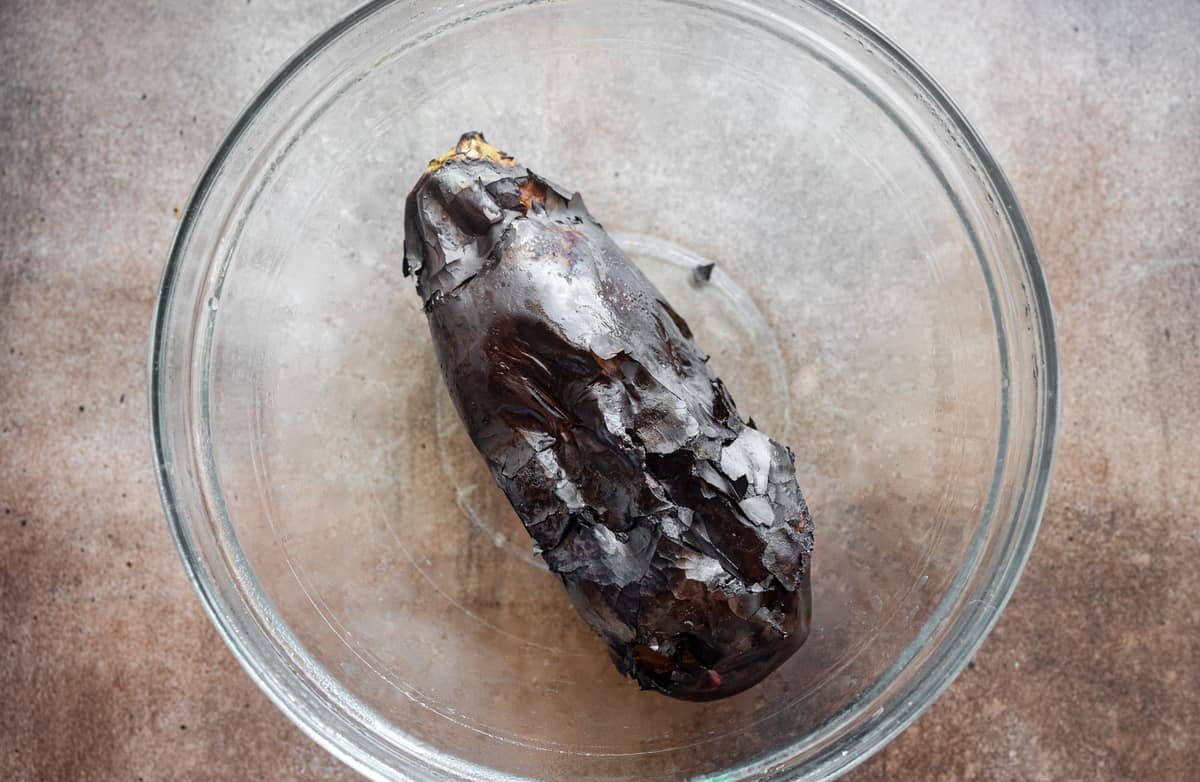
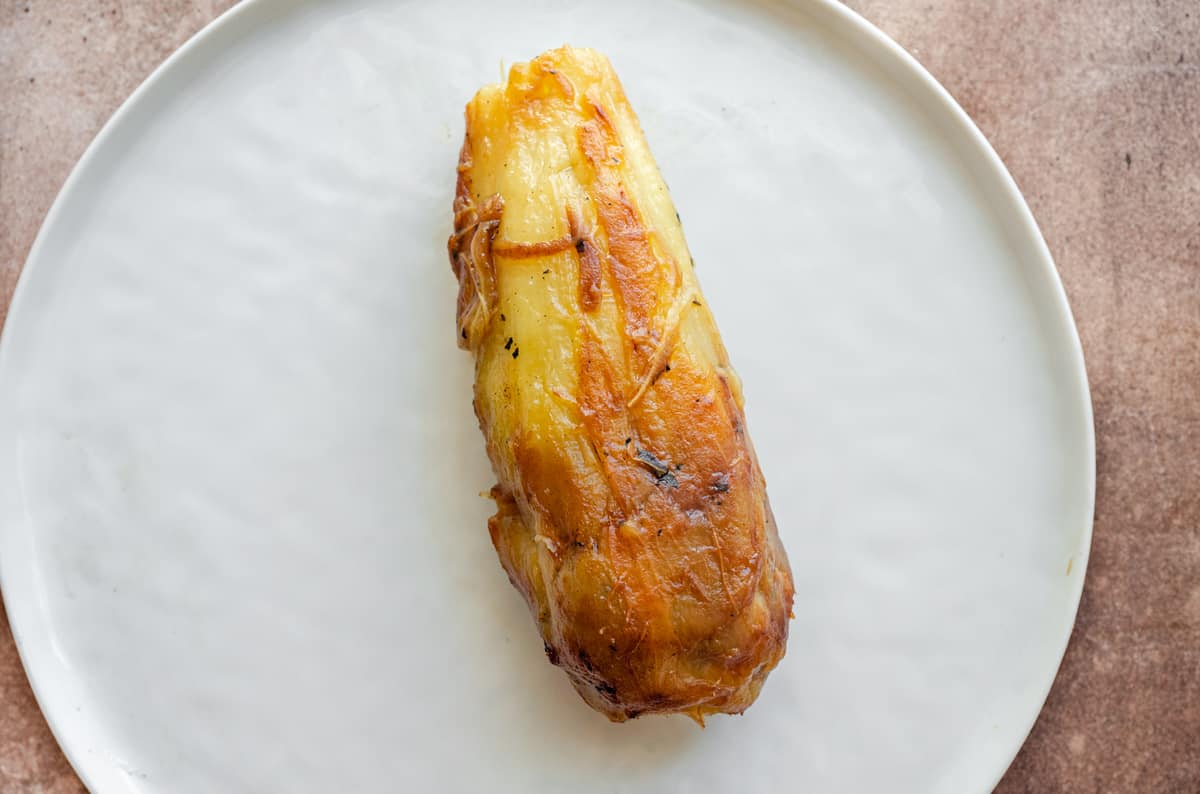
Slice off the head of the eggplant and mash the flesh of the eggplant until very soft (use a knife or potato masher).
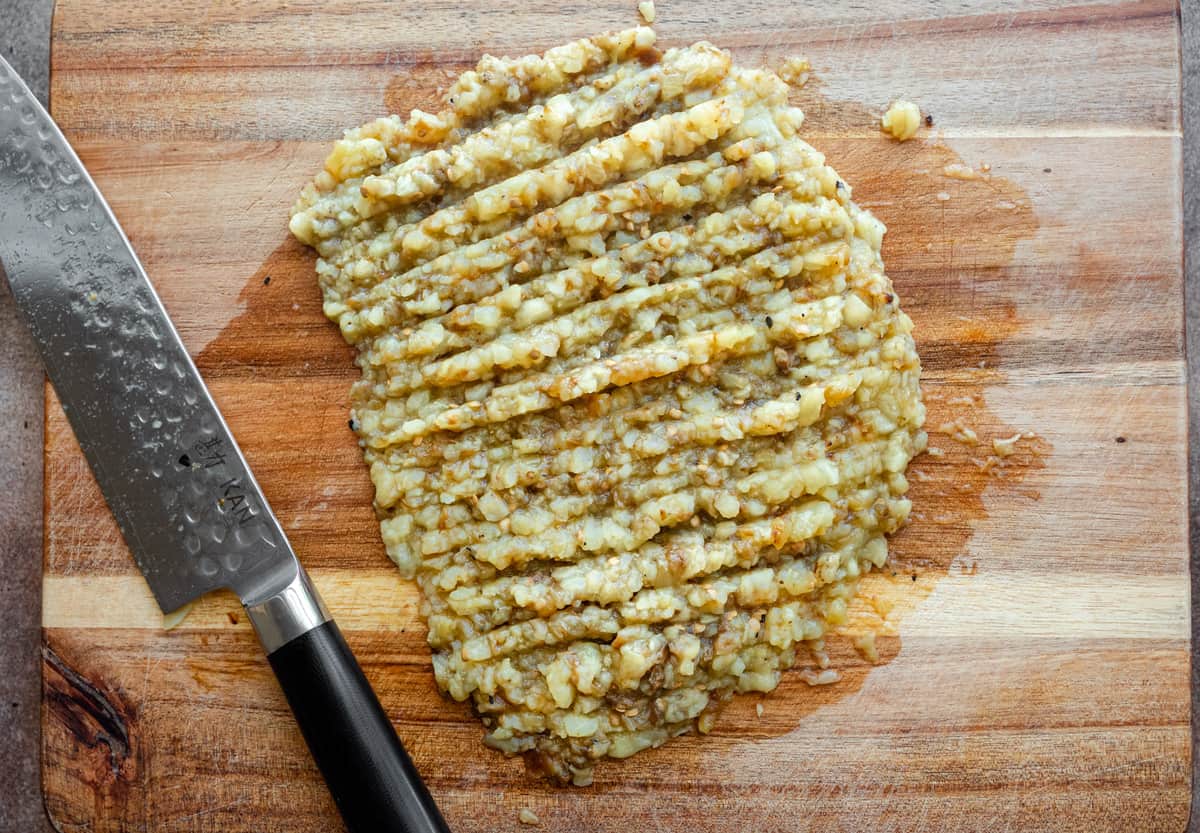
Make the bharta (filling).
The instructions for making the bharta (the filling or the mash) are the same whether you roast the eggplant over the stove flame or cook it on the skillet.
Heat the oil in a frying pan over medium-high heat. Fry the cumin seeds for a minute. Add the onions with a pinch of salt and cook for 4 to 5 minutes.
Cook until onions are softened but not browned. Add the garlic, ginger, serrano peppers, and turmeric, and cook for 60 to 90 seconds.
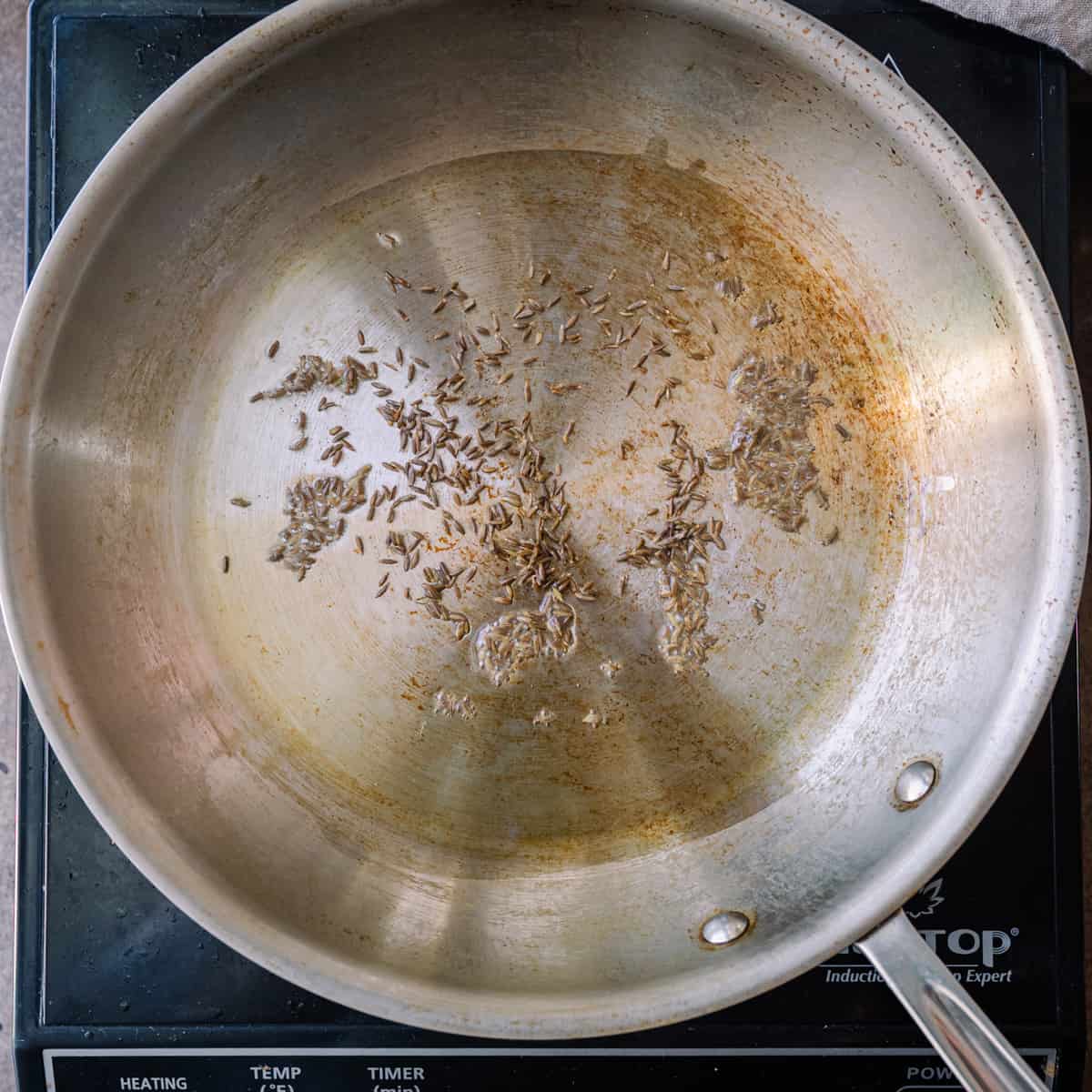
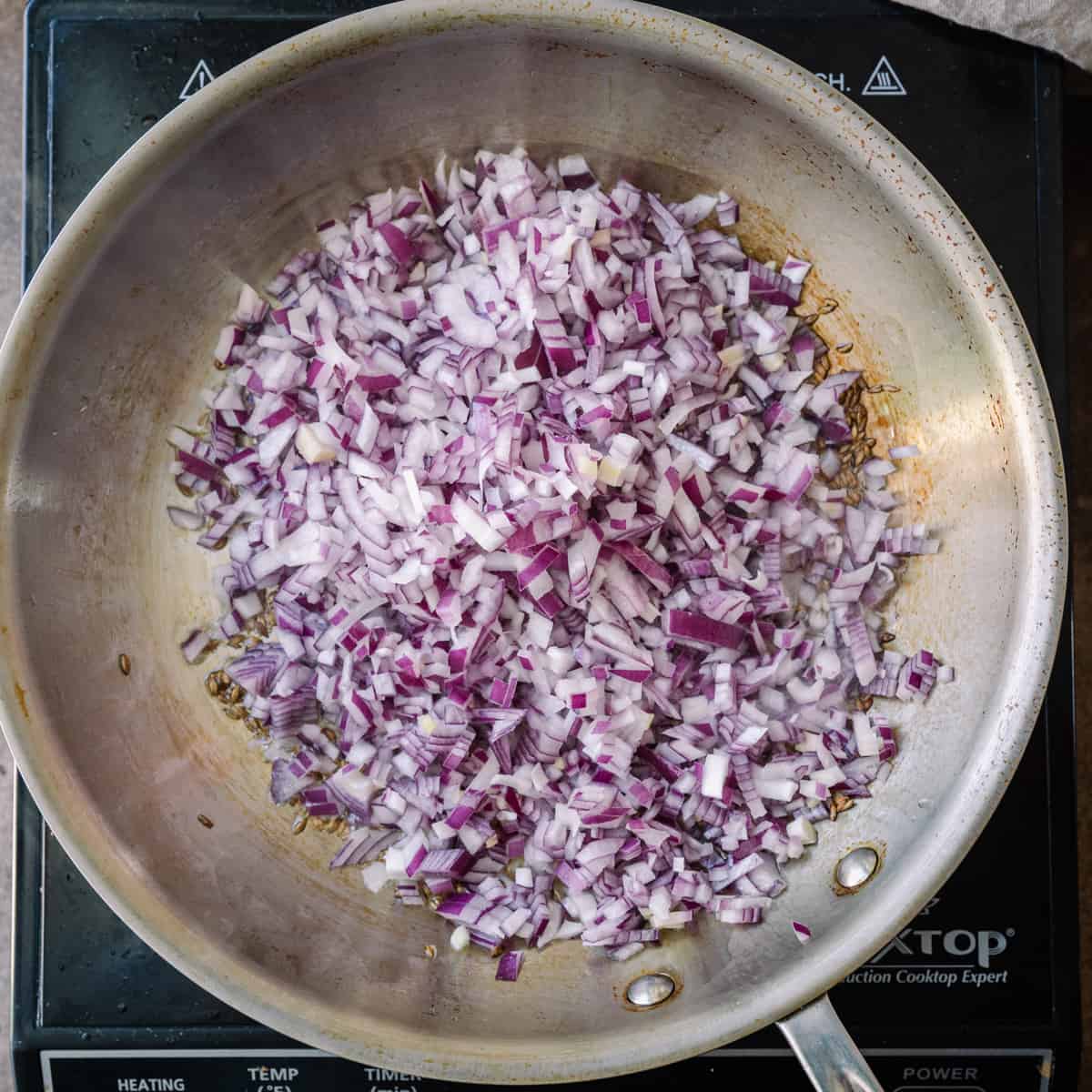
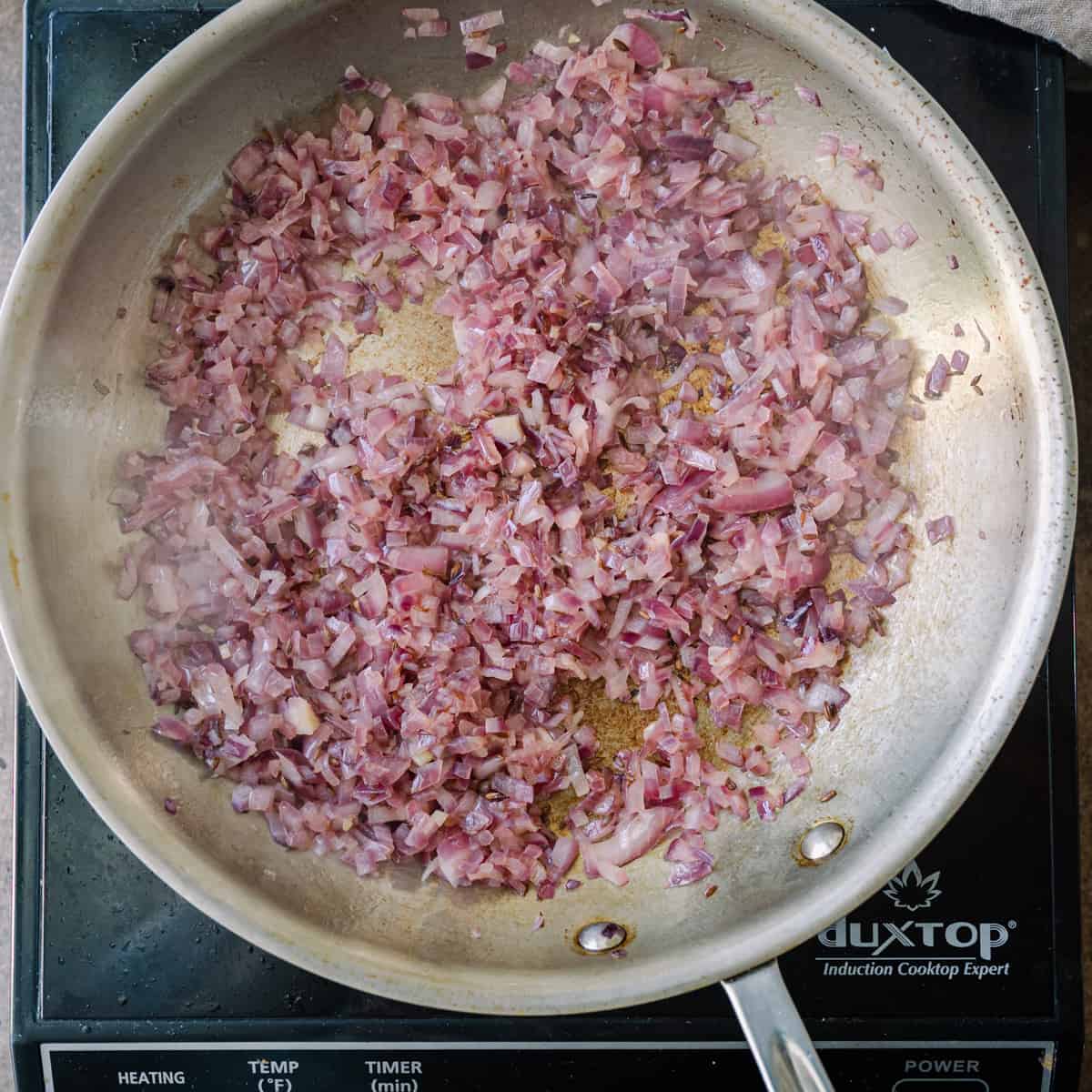
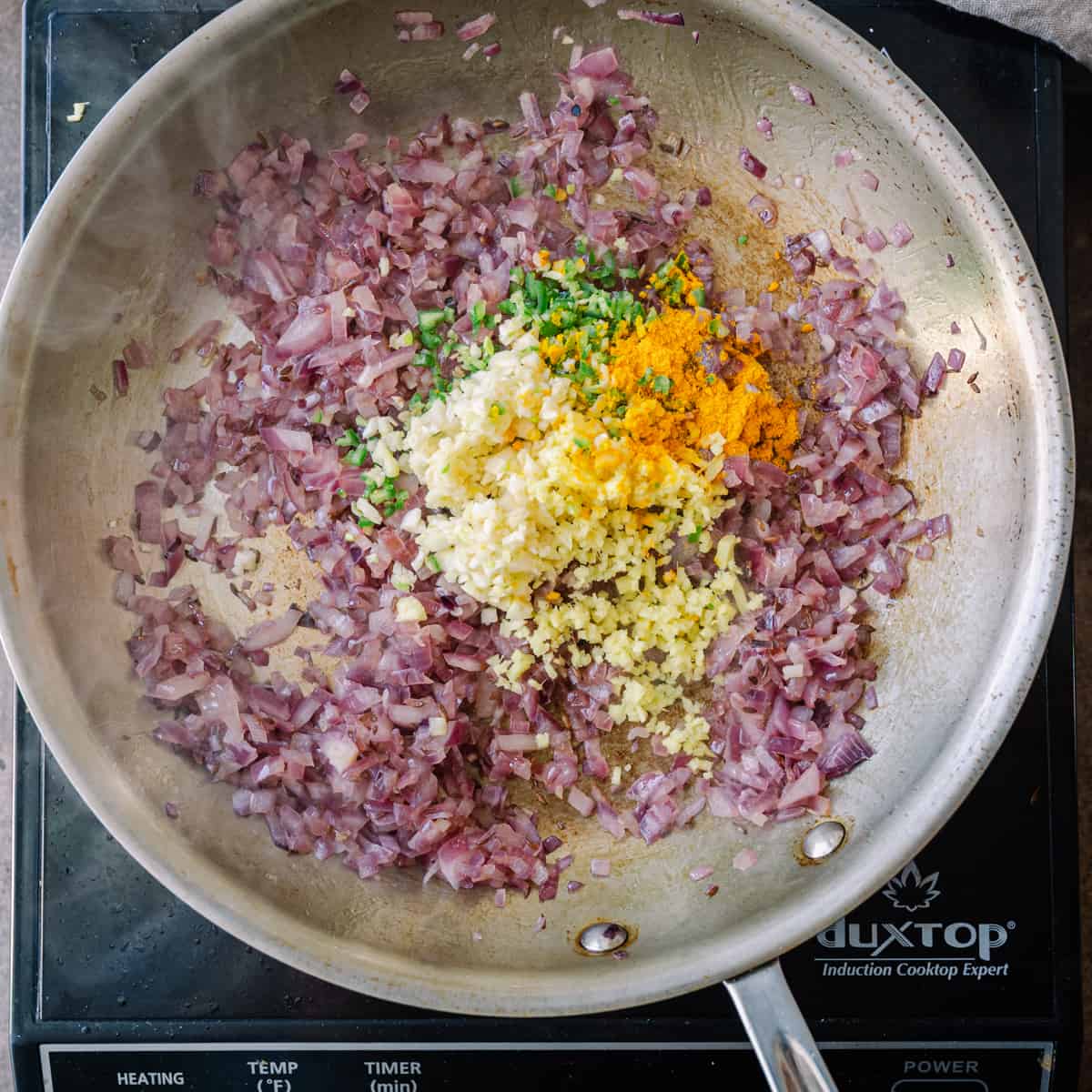
Once very aromatic, add the tomatoes, salt, and coriander.
Cook until the tomatoes are soft, well incorporated, and start to release oil, about 5 minutes.
Add in the mashed eggplant mixture and kashmiri chili powder and toss well to combine.
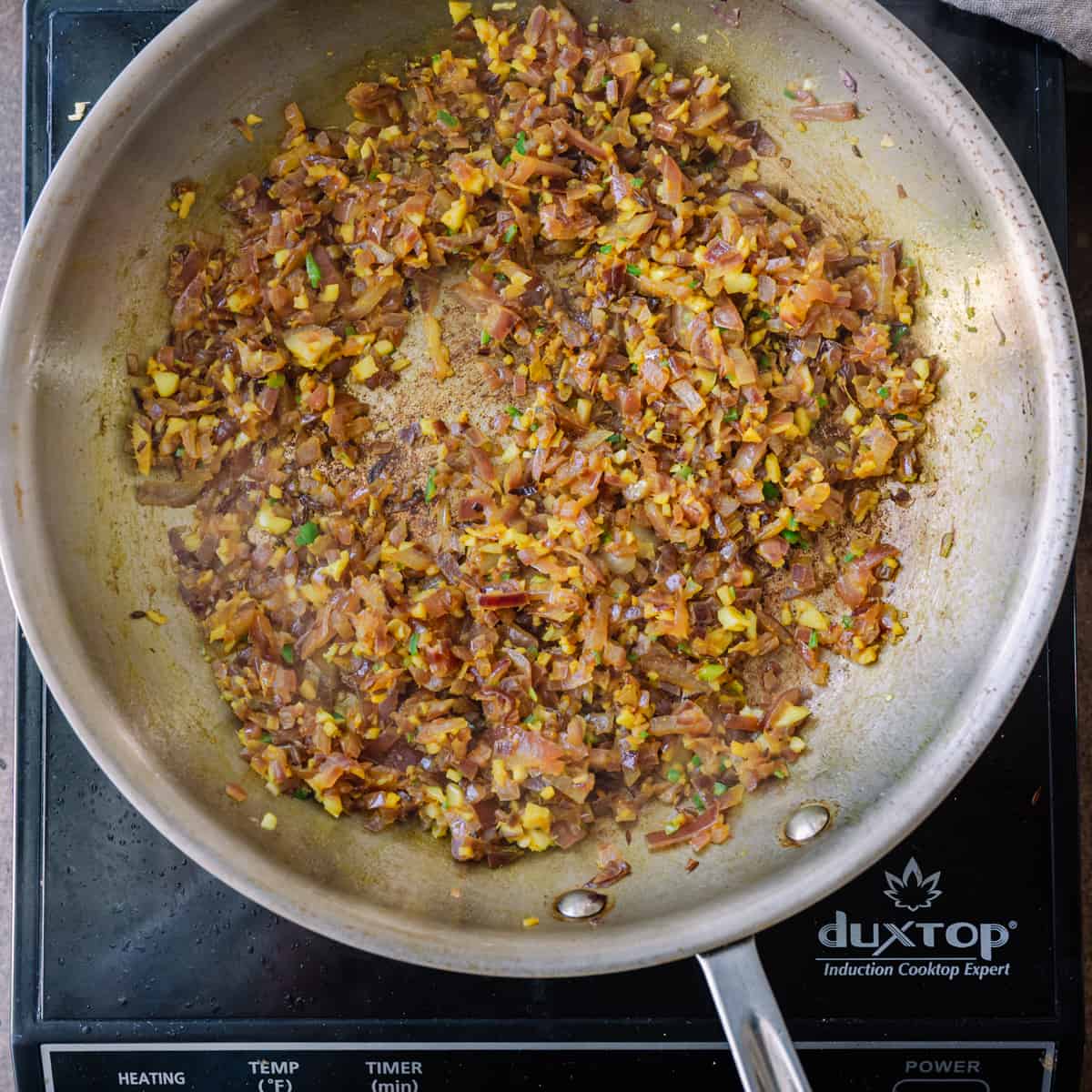
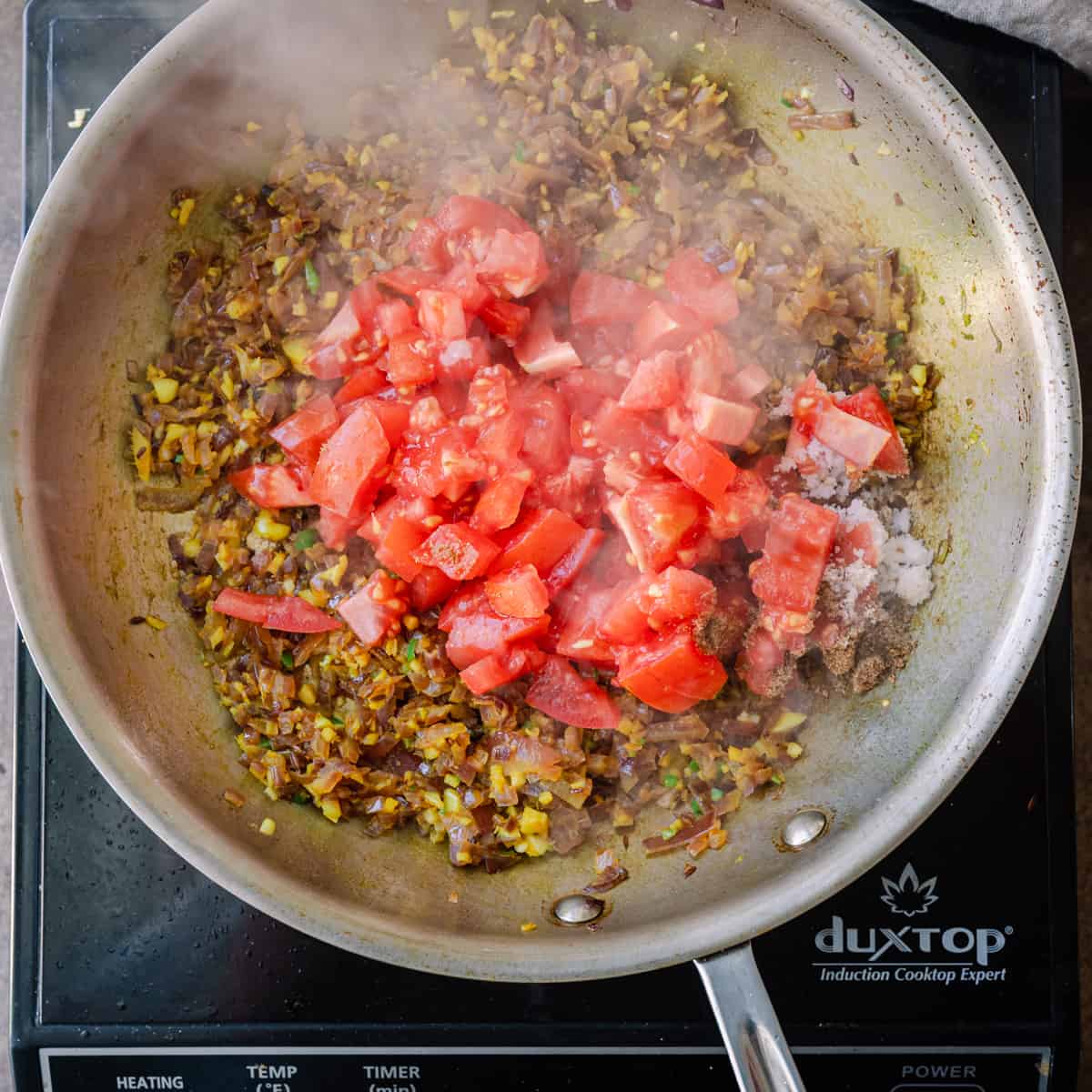
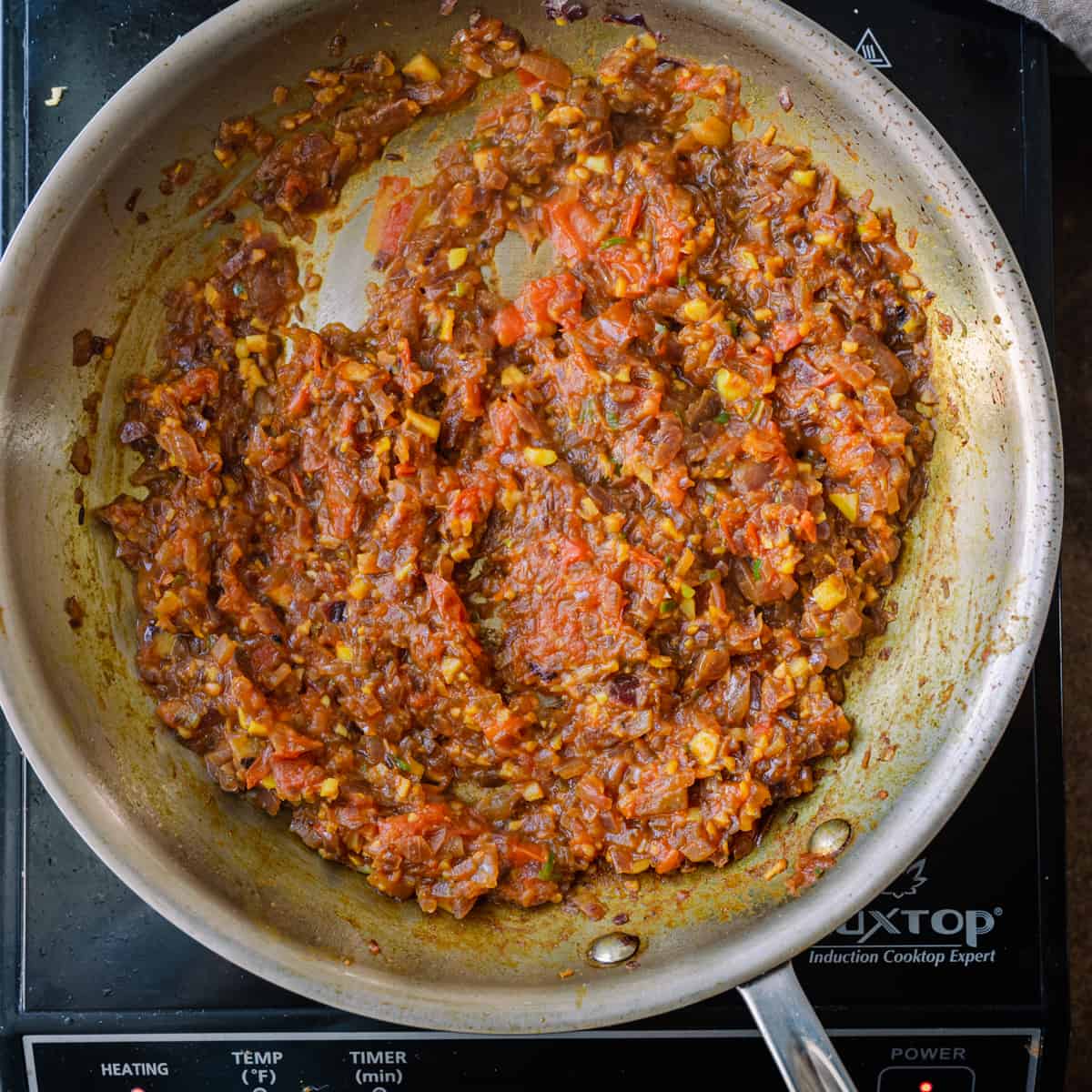
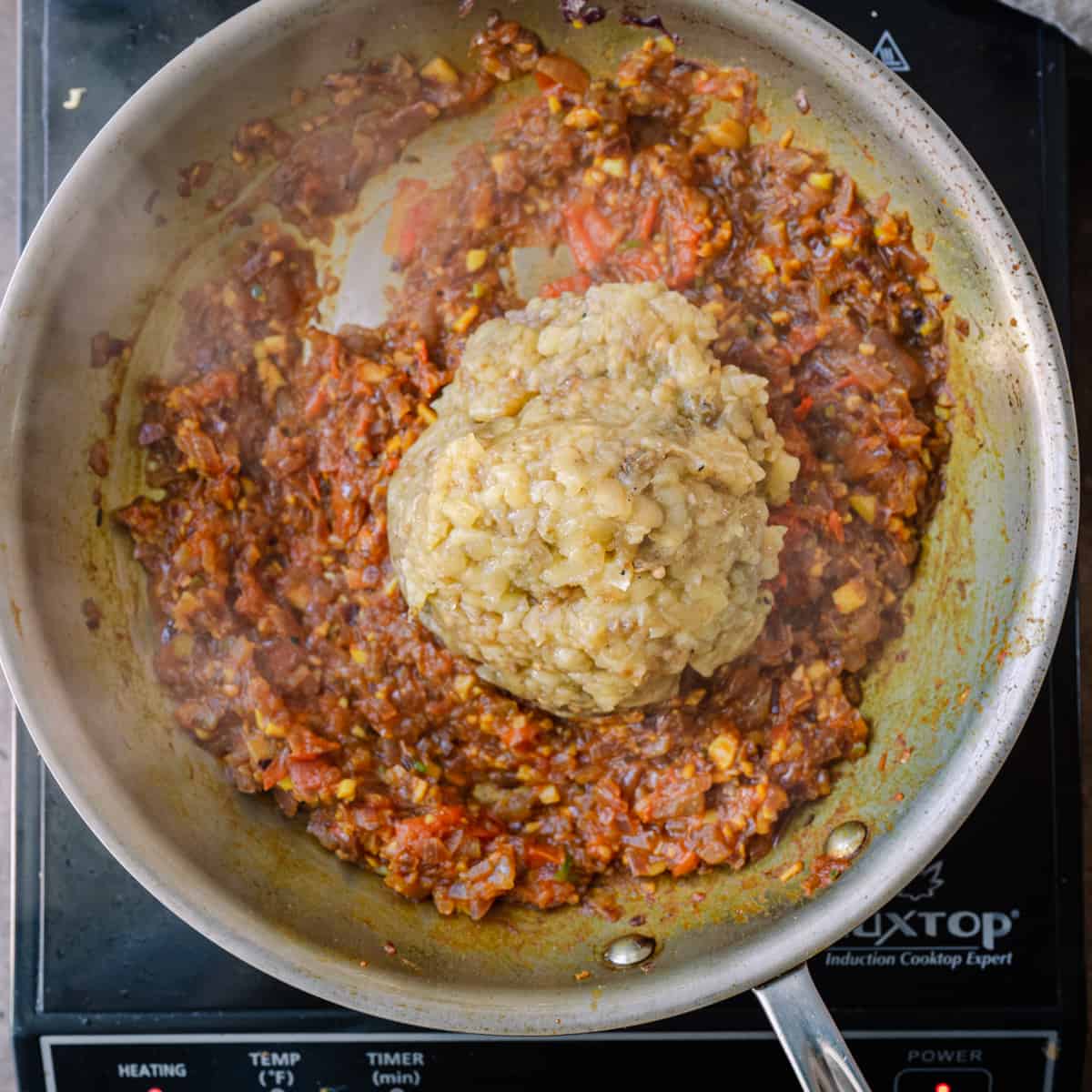
Reduce the heat and cook for 3 to 5 minutes, stirring the eggplant into the bharta and mashing together. Add in the garam masala and chopped cilantro and season with salt.
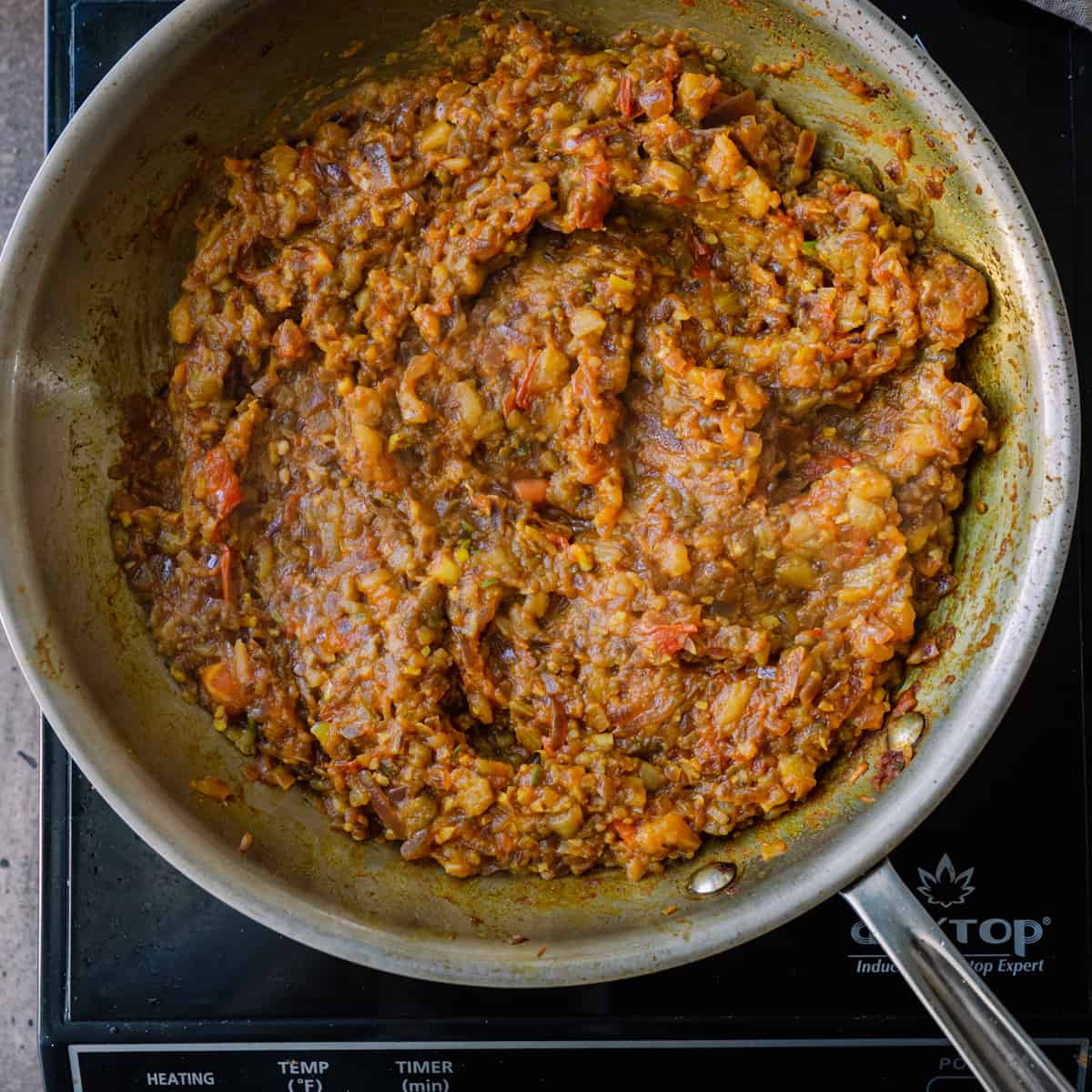
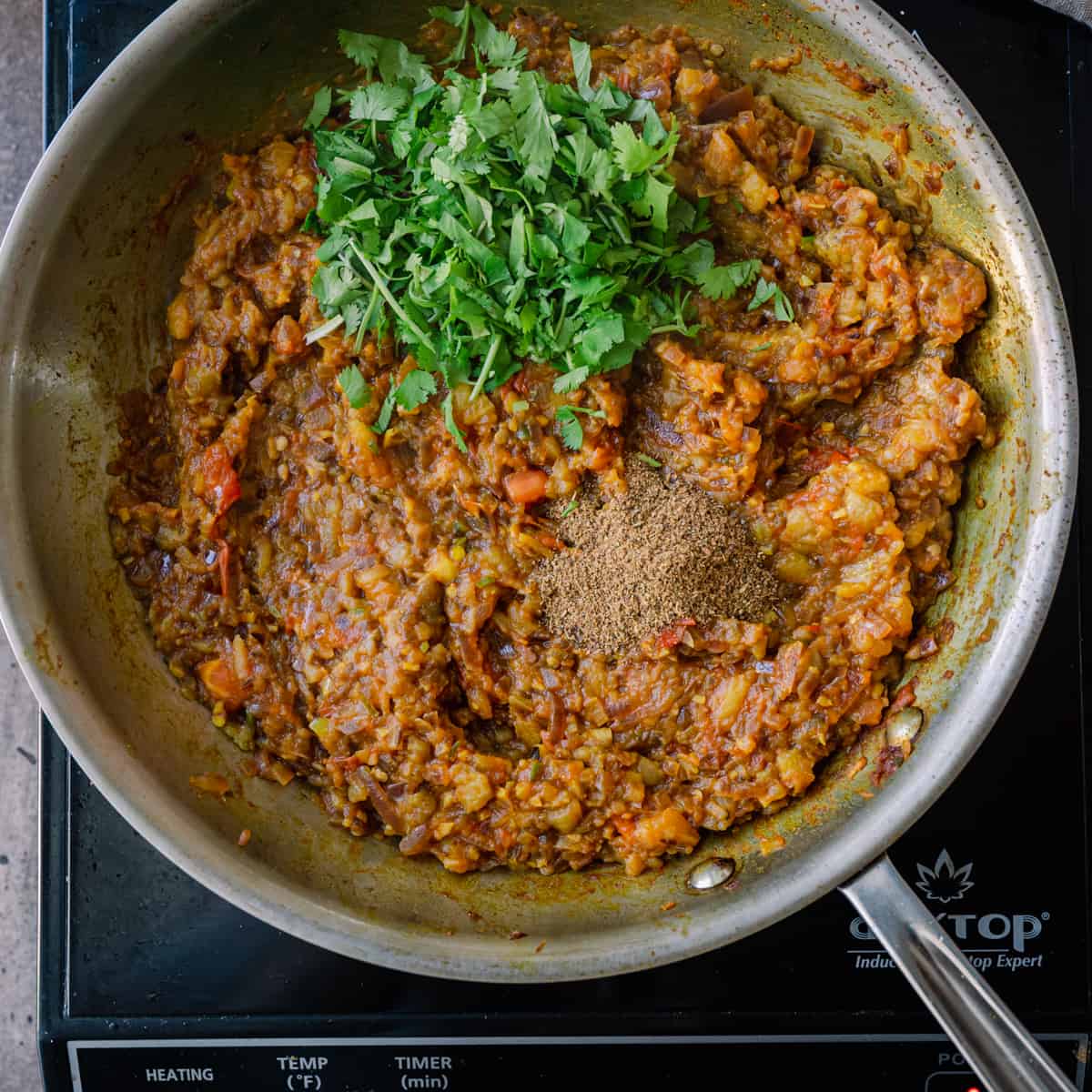
Tips for Making Baingan Bharta
The eggplant needs to be very soft.
When smoking the eggplant over an open flame, wait until the eggplant is very soft. You might think it’s done because the skin is charred, but you need to test the fattest part of the eggplant with a paring knife. If there’s some resistance, it’s not ready. If there’s no resistance, like in the video below, it’s good to go.
Worried that the eggplant is charring too much on the outside but not cooking on the inside? Just lower the heat a touch.
How to test eggplant for doneness
Your stove will get messy.
There’s no real way to avoid your stove getting messy when you smoke the eggplant directly over the flame. Some folks say you can line your stove with foil, but I think that’s a fire hazard. Instead, just use a grease-cutting soap and a tough sponge to clean up your stove later. A cleaning solution like Bar Keepers Friend, a baking soda paste, and/or a 1:1 mixture of distilled white vinegar and water will go a long way.
If you don’t want to deal with that, use the stovetop method to cook the eggplant. It’s not the “authentic” way but it’s still delicious, especially if you can add some smokiness through the Dunghar Method (more on that in the first FAQ below).
Don’t forget to briefly steam the charred eggplant.
Once the smoked eggplant is done, transfer it to a bowl and cover it with a plate to steam for 5 minutes. The steam will make it much easier to peel off the skin. It still requires a few minutes and some patience, but it’ll be much harder if you don’t steam it.
Both versions are very delicious.
If you don’t have a gas stove or are nervous about cooking the eggplant on an open flame, don’t worry. The stovetop eggplant version is still very good. You won’t get the same smoky flavor, but it’s still a great dish. Plus, you can add some of that smoky flavor in using another method that takes just a couple minutes (read the first FAQ for more info!).
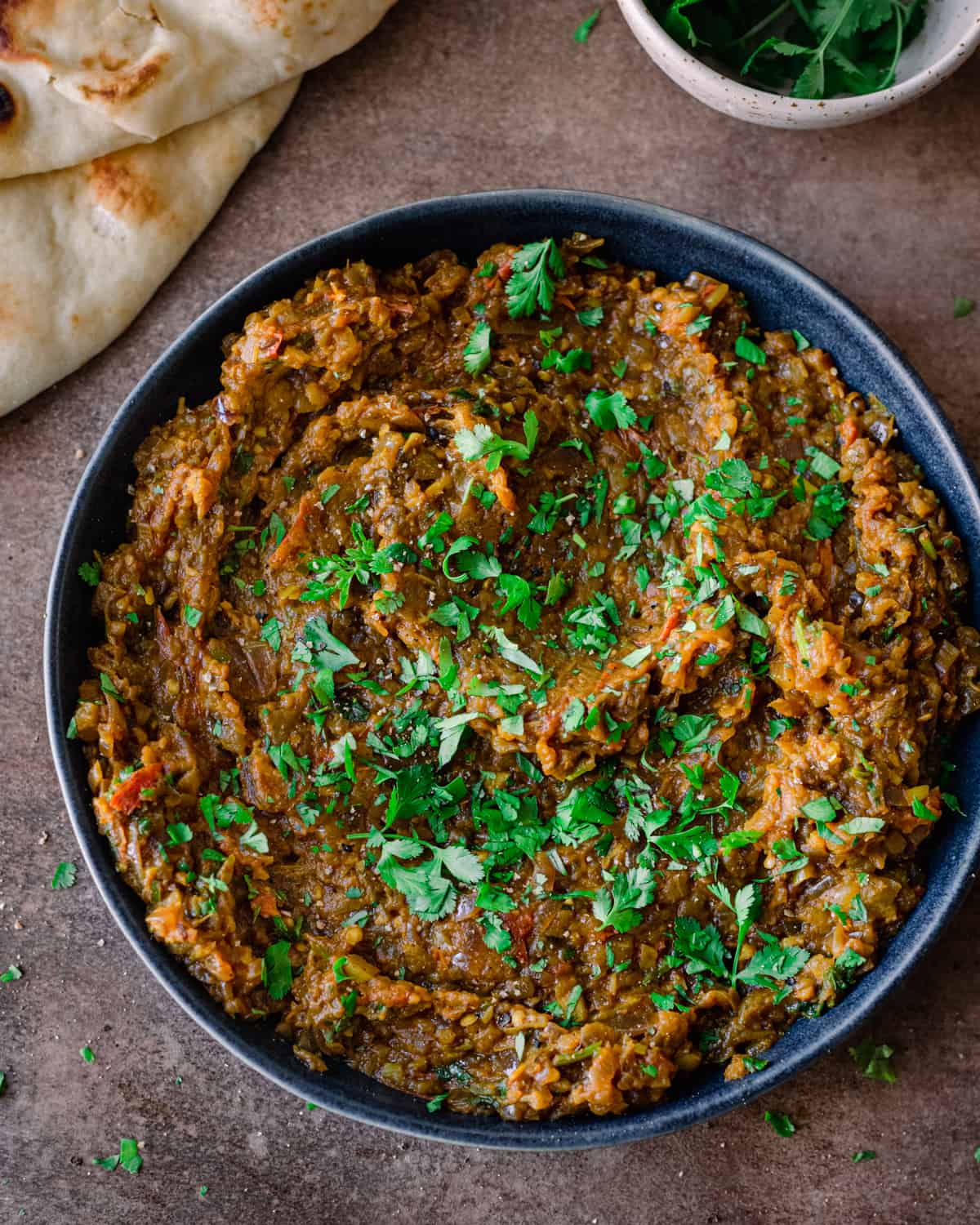
Frequently Asked Questions
Can you get the traditional smoky flavor of baingan bharta without roasting the eggplant on a gas flame?
You can use the traditional Indian method of coal-smoking food called the Dhungar Method. It does not produce the exact same smoky flavor as charring the eggplant over an open flame, but it does add a nice smokiness that is not overpowering. All you need is a piece of lump charcoal, a small bowl, and a tiny bit of oil (you can get charcoal at any hardware store and many grocery stores). There are written instructions for the Dhungar method in the recipe card Notes below.
Note: Please do not try adding liquid smoke (it’s best-suited for American-style dishes like BBQ or vegan “bacon” and does not vibe well with Indian flavors).
Tip: If you want to see a video of how I use the Dhungar method in another recipe, check out my Dal Makhani video on YouTube at the 5:34 mark.
Can I grill the eggplant instead to get the smoky flavor?
As I mentioned earlier, I tried grilling whole eggplant on an indoor grill pan, but it didn’t yield any smoky flavor. But, if you have an outdoor charcoal grill, that would probably be a good option, though it can be time consuming.
Grease your grill grates well and and preheat the grill over medium-high. Once the grill is smoking, add the whole eggplant. Turn occasionally, until the skins are completely charred and the insides are soft (it took 40 to 50 minutes on a grill pan).
How should I serve baingan bharta?
We love it the most with my homemade vegan naan, but it pairs well with virtually any Indian bread such as rotis and parathas. You can even pair it with store-bought flatbread or pita or even grilled bread. Or, serve it over a bed of white or brown rice. Since it’s quite spicy, a nice dollop of coconut yogurt or vegan raita is the perfect pairing.
Can I make this dish ahead of time? Can you freeze baingan bharta?
Yes! You can prepare the eggplant 5 days in advance; just store it in an airtight container in the fridge. You can also make the bharta several days in advance and store it separately.
Leftover baingan bharta will stay good in the fridge for 5 to 6 days; you can also freeze it for a few months with good results.
To reheat, microwave or add to a frying pan on medium-low heat until warmed through.
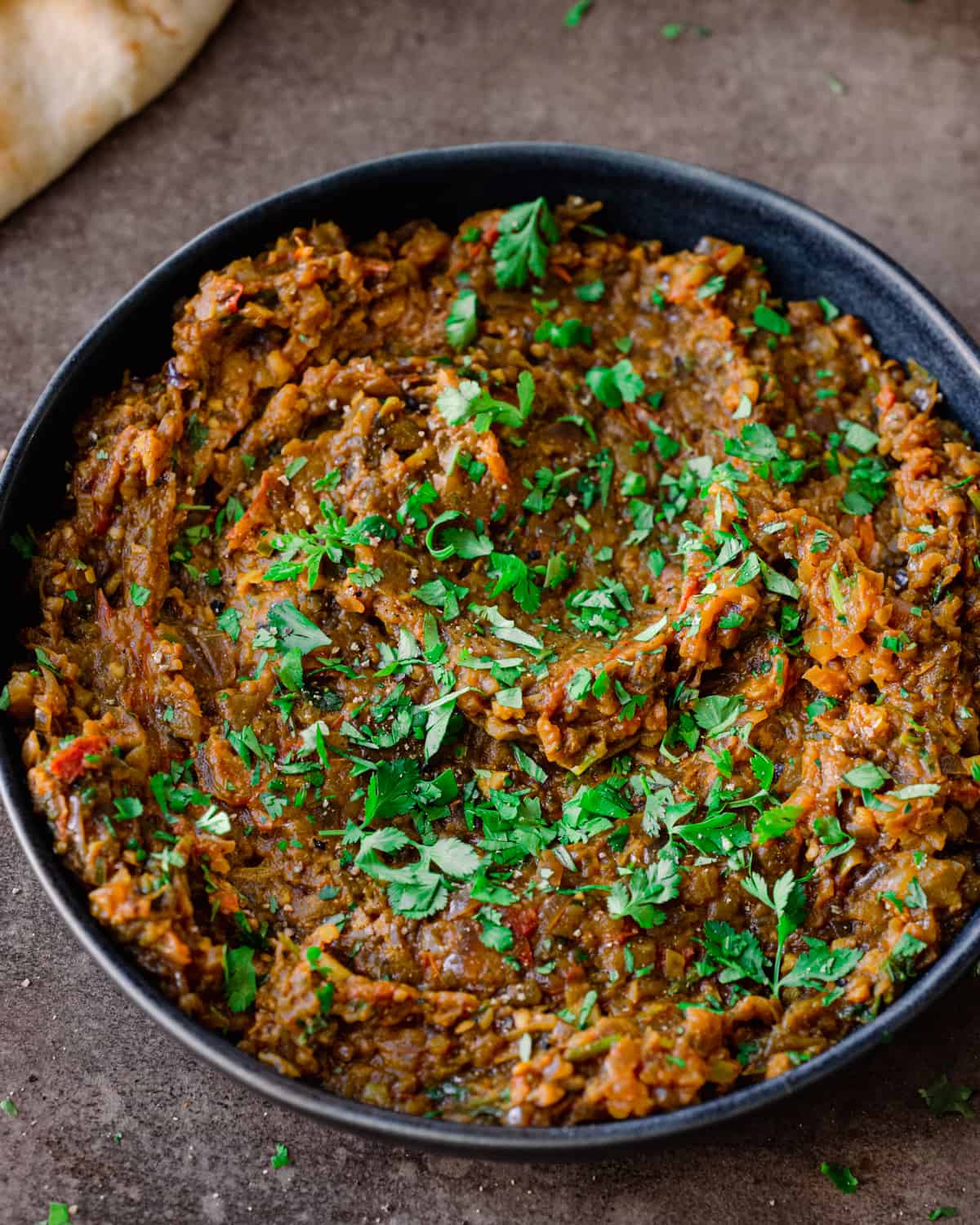
Baingan bharta is THE eggplant dish that will make you fall in love with eggplant! It’s a smoky eggplant mash mixed with a flavorful blend of garlic, ginger, spices, and tomatoes. Choose from the traditional method for the best results—smoking whole eggplants on an open flame—or the sauté method for something a little easier.
Baingan
- 1 medium-sized eggplant (about 1 pound, or 450g)
- Grapeseed oil or avocado oil (or neutral-flavored oil of choice)
Bharta
- 1 ½ tablespoons neutral-flavored oil of choice
- 1 teaspoon cumin seeds
- 1 medium red (or yellow) onion, finely chopped
- 4 garlic cloves, finely chopped
- 1- inch piece ginger, finely chopped or grated
- 1 small serrano pepper, finely chopped (this makes it spicy! omit for mild or moderate heat)
- ½ teaspoon ground turmeric
- 1 teaspoon ground coriander
- 1 ½ teaspoons kosher salt
- 2 medium plum tomatoes, chopped
- ½ teaspoon kashmiri red chile powder*
- 1 teaspoon garam masala
- ½ cup (8g) cilantro leaves and tender stems, chopped
For serving
- Vegan naan, roti, or other flatbread, or cooked white or brown rice
Prepare the baingan (this is for the smoking method; check out the Notes for the alternative sauté method).
Ventilate your kitchen and open the windows. Grab a fan if you have one. Peel any leaves from the top of the eggplant to prevent them from burning. Brush the eggplant with a bit of oil using a pastry brush or your hands, just a light coating.
Turn a gas burner on your stove to medium-low heat. Use tongs to hold the eggplant upright (vertically) and hold the bottom of the eggplant over the flame for 4 to 6 minutes to char the bottom, or until a paring knife can easily pierce the bottom.
Flip the eggplant 180º and use tongs to char the top of the eggplant for 3 minutes, but make sure the stem doesn’t directly touch the flame to avoid burning.
Place the eggplant onto its side (horizontally) and rest it directly on top of the flame, positioning the fatter bottom part directly over the flame. Rotate the eggplant every 2 minutes. After 15 to 16 minutes, the eggplant should be deeply charred and very wrinkly. Insert a paring knife into the fattest part: if it goes in without any resistance and the flesh is very soft, the bottom is done*.
Now it’s time to char the top: use tongs to position the skinnier top part of the eggplant directly onto the flame. Cook for 5 to 6 minutes, rotating every 2 minutes, until charred and wrinkly.
*NOTE: If you feel any resistance, cook for another few minutes.
Turn off the heat and use tongs to transfer the eggplant to a bowl, and cover with a plate to steam for 5 minutes. Uncover and use your hands to peel off the skin, removing any ashy black bits from the flesh. You may want to dip your hands in a bit of water to make it easier to peel.
Slice off the head of the peeled eggplant. Using a knife, flat ended spatula, or potato masher, mash the flesh of the eggplant.
Make the bharta. Heat the 1 1/2 tablespoons of oil in a medium frying pan over medium-high heat. Once hot, add the cumin seeds and cook for 1 minute, tossing or swirling the pan frequently to prevent burning. Add the onions with a pinch of salt and cook for 4 to 5 minutes, but don’t let them brown. Add the garlic, ginger, serrano peppers, and turmeric, and cook, stirring frequently for 60 to 90 seconds. Add the coriander, salt, and tomatoes, and cook until the oil starts to release from the tomatoes and the tomatoes are soft, about 5 minutes.
Add in the mashed eggplant mixture and red chile powder and toss well to combine. Reduce the heat to medium or medium-low and cook for 3 to 5 minutes, stirring often and mashing together. Add in the garam masala and chopped cilantro and season with ¼ teaspoon kosher salt.
Serve warm with bread or rice of choice.
Sauté method for the baingan (eggplant):
- Peel the eggplant. Slice in half lengthwise, then cut each half lengthwise again into 4 wedges and then cut each wedge again into 8 pieces. Finally, cut the wedges into ½-inch pieces.
- Heat 2 1/2 tablespoons of neutral-flavored oil in a large nonstick frying pan over medium-high heat. Once the oil is hot and shimmering, reduce the heat to medium and add the eggplant and season with ½ teaspoon kosher salt. Cook, tossing occasionally, for about 6 minutes, until the eggplant starts to break down. Reduce the heat to medium and continue cooking until the eggplant is soft and jam-like and there’s no resistance when pierced with a fork, about 20 minutes.
- Mash the eggplant as described in the instructions above.
Dhungar Method (coal smoking method)
If you are using the sauté method but want to infuse some smoky flavor into the dish, here’s how to do it:
You’ll need:
- 1 to 2- inch piece of lump charcoal
- ½ teaspoon neutral-flavored oil
- When the baingan bharta is done, light the charcoal over a gas flame until smoking and red hot. Place a small stainless steel or glass bowl in the middle of the bharta (mash). Add the hot charcoal to the small bowl, pour ½ tsp oil on top of the charcoal, and cover the frying pan with a lid as soon as it starts smoking. Keep covered for 2 to 3 minutes to infuse the smoke.
Bharta Notes
*If omitting the serrano pepper but you want some heat, use more kashmiri chile powder, 1 to 1 1/2 teaspoons.
Calories: 224kcal | Carbohydrates: 28g | Protein: 6g | Fat: 9g | Saturated Fat: 1g | Polyunsaturated Fat: 1g | Monounsaturated Fat: 9g | Sodium: 1793mg | Potassium: 1161mg | Fiber: 12g | Sugar: 13g | Vitamin A: 4751IU | Vitamin C: 37mg | Calcium: 111mg | Iron: 3mg


